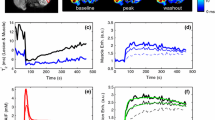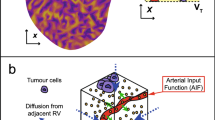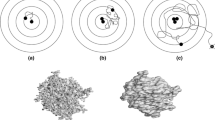Abstract
Purpose
This study aims to develop a constrained local arterial input function (cL-AIF) to improve quantitative analysis of dynamic contrast-enhanced (DCE)-magnetic resonance imaging (MRI) data by accounting for the contrast-agent bolus amplitude error in the voxel-specific AIF.
Procedures
Bayesian probability theory-based parameter estimation and model selection were used to compare tracer kinetic modeling employing either the measured remote-AIF (R-AIF, i.e., the traditional approach) or an inferred cL-AIF against both in silico DCE-MRI data and clinical, cervical cancer DCE-MRI data.
Results
When the data model included the cL-AIF, tracer kinetic parameters were correctly estimated from in silico data under contrast-to-noise conditions typical of clinical DCE-MRI experiments. Considering the clinical cervical cancer data, Bayesian model selection was performed for all tumor voxels of the 16 patients (35,602 voxels in total). Among those voxels, a tracer kinetic model that employed the voxel-specific cL-AIF was preferred (i.e., had a higher posterior probability) in 80 % of the voxels compared to the direct use of a single R-AIF. Maps of spatial variation in voxel-specific AIF bolus amplitude and arrival time for heterogeneous tissues, such as cervical cancer, are accessible with the cL-AIF approach.
Conclusions
The cL-AIF method, which estimates unique local-AIF amplitude and arrival time for each voxel within the tissue of interest, provides better modeling of DCE-MRI data than the use of a single, measured R-AIF. The Bayesian-based data analysis described herein affords estimates of uncertainties for each model parameter, via posterior probability density functions, and voxel-wise comparison across methods/models, via model selection in data modeling.





Similar content being viewed by others
References
Tofts PS, Brix G, Buckley DL et al (1999) Estimating kinetic parameters from dynamic contrast-enhanced T1-weighted MRI of a diffusable tracer: standardized quantities and symbols. J Magn Reson Imaging 10:223–232
Naish JH, Kershaw LE, Buckley DL et al (2009) Modeling of contrast agent kinetics in the lung using T1-weighted dynamic contrast-enhanced MRI. Magn Reson Med 61:1507–1514
Leuthardt EC, Duan C, Kim MJ et al (2016) Hyperthermic laser ablation of recurrent glioblastoma leads to temporary disruption of the peritumoral blood brain barrier. PLoS One 11:e0148613. doi:10.1371/journal.pone.0148613
Sourbron SP, Buckley DL (2013) Classic models for dynamic contrast-enhanced MRI. NMR Biomed 26:1004–1027
Yankeelov TE, Lepage M, Chakravarthy A et al (2007) Integration of quantitative DCE-MRI and ADC mapping to monitor treatment response in human breast cancer: initial results. Magn Reson Imaging 25:1–13
Semple SIK, Harry VN, Parkin DE, Gilbert FJ (2009) A combined pharmacokinetic and radiologic assessment of dynamic contrast-enhanced magnetic resonance imaging predicts response to chemoradiation in locally advanced cervical cancer. Int J Radiat Oncol 75:611–617
Parker GJM, Roberts C, Macdonald A et al (2006) Experimentally-derived functional form for a population-averaged high-temporal-resolution arterial input function for dynamic contrast-enhanced MRI. Magn Reson Med 56:993–1000
Port RE, Knopp MV, Brix G (2001) Dynamic contrast-enhanced MRI using Gd-DTPA: Interindividual variability of the arterial input function and consequences for the assessment of kinetics in tumors. Magn Reson Med 45:1030–1038
Calamante F (2005) Bolus dispersion issues related to the quantification of perfusion MRI data. J Magn Reson Imaging 22:718–722
Schmitt M, Viallon M, Thelen M, Schreiber WG (2002) Quantification of myocardial blood flow and blood flow reserve in the presence of arterial dispersion: a simulation study. Magn Reson Med 47:787–793
Murase K, Yamazaki Y, Miyazaki S (2004) Deconvolution analysis of dynamic contrast-enhanced data based on singular value decomposition optimized by generalized cross validation. Magn Reson Med Sci MRMS Off J Jpn Soc Magn Reson Med 3:165–175
Wu O, Østergaard L, Koroshetz WJ et al (2003) Effects of tracer arrival time on flow estimates in MR perfusion-weighted imaging. Magn Reson Med 50:856–864
Calamante F, Gadian DG, Connelly A (2000) Delay and dispersion effects in dynamic susceptibility contrast MRI: simulations using singular value decomposition. Magn Reson Med Off J Soc Magn Reson Med Soc Magn Reson Med 44:466–473
Rose SE, Janke AL, Griffin M et al (2004) Improved prediction of final infarct volume using bolus delay–corrected perfusion-weighted MRI implications for the ischemic penumbra. Stroke 35:2466–2471
Korporaal JG, van den Berg CA, Jeukens CR et al (2010) Dynamic contrast-enhanced CT for prostate cancer: relationship between image noise, voxel size, and repeatability 1. Radiology 256:976–984
van Osch MJP, van der Grond J, Bakker CJG (2005) Partial volume effects on arterial input functions: shape and amplitude distortions and their correction. J Magn Reson Imaging J Mang Reson Imaging 22:704–709
Fluckiger JU, Schabel MC, DiBella EV (2009) Model-based blind estimation of kinetic parameters in dynamic contrast enhanced (DCE)-MRI. Magn Reson Med 62:1477–1486
Fluckiger JU, Schabel MC, DiBella EVR (2010) Toward local arterial input functions in dynamic contrast-enhanced MRI. J Magn Reson Imaging 32:924–934
Lee JJ, Bretthorst GL, Derdeyn CP et al (2010) Dynamic susceptibility contrast MRI with localized arterial input functions. Magn Reson Med 63:1305–1314
Duan C, Kallehauge JF, Bretthorst GL et al (2017) Are complex DCE-MRI models supported by clinical data? Magn Reson Med 77:1329–1339
Jaynes ET (2003) Probability theory: the logic of science. Cambridge University Press
Kallehauge JF, Tanderup K, Duan C et al (2014) Tracer kinetic model selection for dynamic contrast-enhanced magnetic resonance imaging of locally advanced cervical cancer. Acta Oncol Stockh Swed 53:1064–1072
Sharma P, Socolow J, Patel S et al (2006) Effect of Gd-DTPA-BMA on blood and myocardial T1 at 1.5T and 3T in humans. J Magn Reson Imaging 23:323–330
Donaldson SB, West CML, Davidson SE et al (2010) A comparison of tracer kinetic models for T1-weighted dynamic contrast-enhanced MRI: application in carcinoma of the cervix. Magn Reson Med Off J Soc Magn Reson Med Soc Magn Reson Med 63:691–700
Kallehauge J, Nielsen T, Haack S et al (2013) Voxelwise comparison of perfusion parameters estimated using dynamic contrast enhanced (DCE) computed tomography and DCE-magnetic resonance imaging in locally advanced cervical cancer. Acta Oncol 52:1360–1368
Acknowledgments
This project was supported by funding from the Alvin J. Siteman Comprehensive Cancer Center (P30 CA091842).
Author information
Authors and Affiliations
Corresponding author
Ethics declarations
Conflict of Interest
The authors declare that they have no conflict of interest.
Electronic supplementary material
ESM 1
(PDF 333 kb)
Rights and permissions
About this article
Cite this article
Duan, C., Kallehauge, J.F., Pérez-Torres, C.J. et al. Modeling Dynamic Contrast-Enhanced MRI Data with a Constrained Local AIF. Mol Imaging Biol 20, 150–159 (2018). https://doi.org/10.1007/s11307-017-1090-x
Published:
Issue Date:
DOI: https://doi.org/10.1007/s11307-017-1090-x




